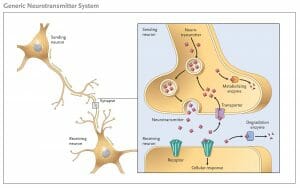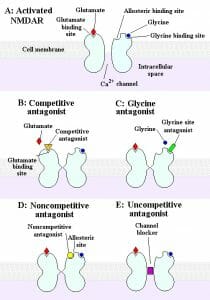NMDA Receptor Definition
NMDA receptors are neurotransmitter receptors that are located in the post-synaptic membrane of a neuron. They are proteins embedded in the membrane of nerve cells that receive signals across the synapse from a previous nerve cell. They are involved in signal transduction and control the opening and closing of ion channels. They are believed to play an important role in learning and memory formation.
NMDA Receptor Structure
NMDA receptors are proteins that are embedded in the membrane of post-synaptic neurons. The N-methyl-D-aspartate (NMDA) receptors are made up of five subunits that have a similar amino acid sequence to other glutamate membrane receptor classes such as the AMPA (α-amino-3-hydroxy-5-methly-4-isoxazole propionic acid) receptors and the kainate receptors. The exact structure of the NMDA receptors varies depending on stage of maturity, location in the body, and the species in question.
The five subunits are categorized into two subfamilies of glutamate receptor channel subunits. These subunits are made up of an amino-terminal signal peptide and four central segments that are hydrophobic. The amino acid sequences are similar among subunits of the same subunit family, but can differ significantly between subfamilies. For example, in all types of subunits the second central segment contains an asparagine residue in a location such that it is involved in the Ca2+ permeability of the ion channel.
NMDA Receptor Function
The NMDA receptor is involved in the long-term potentiation of an action potential. Full activation of NMDA receptors is both voltage-gated and ligand-gated. The ion channels will only open if the post-synaptic membrane has already been depolarized, and the neurotransmitters glutamate and glycine are attached. There is a voltage-dependent Mg2+ block that prevents the opening of the NMDA receptor ion channels when the membrane is not depolarized; it acts as an antagonist. Membrane depolarization occurs when the neurotransmitter glutamate interacts with AMPA receptors in the membrane which then open ion channels that allow Na+ and K+ to enter the cell. This causes the resting membrane potential, which is negatively charged relative to outside of the neuron, to move closer to zero as the positive ions diffuse into the cell. When glutamate and glycine then bind to the NMDA receptors the conformation of the protein changes and Ca2+ permeable ion channels open. As Ca2+ enters the neuron it triggers phosphorylation of the AMPA receptors in the membrane, causing the AMPA receptors to become more responsive to neurotransmitters (glutamate). It also increases the number of AMPA receptors in the membrane, thus increasing the influx of positive Na+ and K+ ions and maintaining the membrane depolarization, and the action potential it produces.
Glutamate
Glutamate is an excitatory neurotransmitter involved in many functions including learning, the formation of new memories, and movement. It is the most common excitatory neurotransmitter found in the brain, and thus likely plays a crucial role in normal brain function. Some neurodegenerative conditions may be linked to overexpression of glutamate resulting in neuron death. These include damage caused by oxygen deprivation, hypoglycemia, trauma, seizures, and disease including Huntington’s disease.

This figure depicts a generic neuron and synapse. The NMDA receptors would be the receptors located in the receiving neuron that interact with the neurotransmitters coming from the sending neuron.

This figure depicts the NMDA receptor (NMDAR) in a number of conformations: A. activated by glutamate and glycine; B. & C. closed due to a competitive antagonist; D. & E. closed due to a non-competitive or uncompetitive antagonist.
Quiz
1. How is the activity of NMDA receptors controlled?
A. voltage-gated
B. ligand-gated
C. enzyme antagonist
D. all of the above
2. How many classes of glutamate receptor subunits are found in NMDA receptors?
A. two
B. five
C. ten
D. twelve
3. What neurological functions are not thought to be influenced by glutamate activity?
A. memory formation
B. learning
C. arousal
D. movement
References
- Campbell, N. A., & Reece, J. B. (2005).Biology, 7th. ed. Ch. 48. San Francisco, CA: Benjamin Cummings. ISBN: 0-8053-7171-0.
- Comer, R., Ogden, N., Boyes, M., & Gould, E. (2015).Psychology Around US, 2nd. ed. Ch. 13. Toronto, ON: John Wiley & Sons Canada, Ltd.
- Mori, H., & Mishina, M. (1995). “Structure and function of the NMDA receptor channel”. Neuropharmacol. 34: 1219–37.
